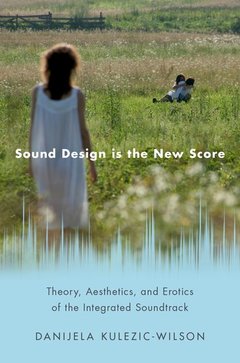Description
Sound Design is the New Score
Theory, Aesthetics, and Erotics of the Integrated Soundtrack
Oxford Music/Media Series
Author: Kulezic-Wilson Danijela
Language: English
Sound Design is the New Score
Publication date: 01-2020
180 p. · 23.9x15.7 cm · Hardback
Publication date: 01-2020
180 p. · 23.9x15.7 cm · Hardback
Sound Design is the New Score
Publication date: 01-2020
180 p. · 23.4x15.5 cm · Paperback
Publication date: 01-2020
180 p. · 23.4x15.5 cm · Paperback
Description
/li>Biography
/li>
The practice of blurring the line between score and sound design has transformed contemporary film soundscape by challenging not only the long-established hierarchical relationships between dialogue, music, and sound effects, but also the modes of perception shaped by classical soundtrack practices. The methods of this new trend rely on the language of contemporary popular and art music, producing soundtracks in which it is difficult to tell the difference between score and ambient sound, where pieces of electroacoustic music are merged with diegetic sound, sound effects are absorbed into the score or treated as music, and diegetic sound is treated as musique concrète. In Sound Design is the New Score, Kulezic-Wilson explores theoretical, aesthetic, and sensuous dimensions of this new trend, providing a multifaceted portrait of a practice which recognizes the interconnectedness of all soundtrack elements and emphasizes their inherent musicality. The aesthetic concerns of this practice are illuminated through the concept of the aesthetics of reticence which rejects classical narrative and scoring conventions and uses integrated soundtrack strategies to create the space for mystery in art and for individuality in the cinematic experience. The book's emphasis on sensuous and musical aspects of this practice, informed by the feminist discourse on the erotics of art, challenges popular notions about sensory cinema, demonstrating that the sensuousness of film form and its soundscapes is more sophisticated than simply being the result of excessive sensory stimulation facilitated by the use of digital technology or the "intensified" aesthetics it inspires. The discussion is supported by a wide range of case studies from American Independent, Asian, Australian, and European cinemas, including films by Shane Carruth, Claire Denis, Hou Hsiao-Hsien, Harmony Korine, David Michôd, Gus Van Sant, and Peter Strickland.
Danijela Kulezic-Wilson teaches film music, film sound, and intermedia at University College Cork. Her research interests include approaches to film that emphasize its inherent musical properties, the musicality of sound design, and musical aspects of Beckett's plays. She is the author of The Musicality of Narrative Film (2015) and co-editor of The Palgrave Handbook of Sound Design and Music in Screen Media: Integrated Soundtracks (2016).
© 2024 LAVOISIER S.A.S.
These books may interest you

Designing Sound for Animation 53.83 €

Designing Sound for Animation 271.33 €


